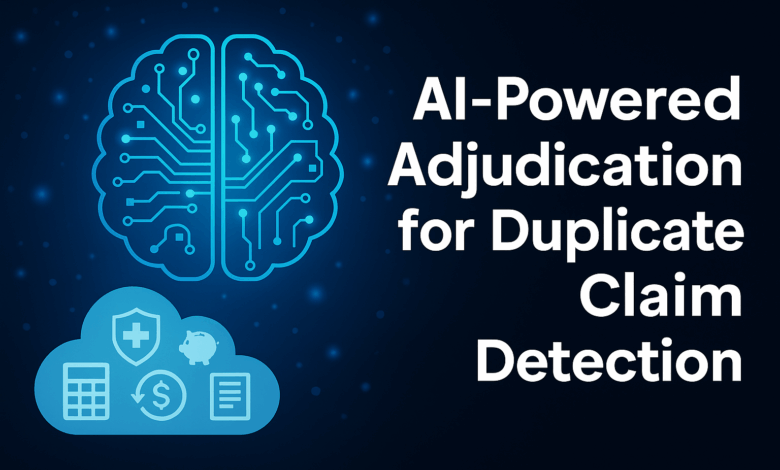
Introduction
In healthcare Insurance duplicate claims create major financial loss and corrective major to identify those claims. If we have proper mechanism to detect the duplicate claims during the pre-adjudication phase it will save millions for Insurance companies. This article explores how will domain and technology come together and make it to identify the duplicate claims with applying specific attributes.
Understanding Duplicate Claims in Adjudication
Duplicate claims scenario happens when the same claim is submitted more than once and reaches the system for processing multiple times. These duplicates claims can submit due to following example simple human errors, technical glitches, or even intentional fraud. When duplicate claims enter the pre-adjudication system which checks whether claims are valid and how much should be paid, they can cause confusion and lead to inaccurate decisions. That is why it is important for detection systems to catch both exact duplicates and claims that are nearly identical, since both can impact the accuracy and integrity of the claims process.
Defining Key Duplicate Parameters
An effective duplicate detection method for adjudication depends on finding essential parameters which show that matching these parameters points to a potential duplicate claim. Some of the most important parameters include:
- Member Identifier and Demographics The combination of member IDs with names and birthdates allows claim systems to accurately identify individual claimants.
- Clinical Procedure Codes Standardized codes such as ICD, CPT, and HCPCS must be used consistently when documenting diagnoses and procedures. The presence of identical service or procedure codes on simultaneous service incidents raises suspicion.
- Service Dates Submission Dates When service dates and claim submission dates coincide or overlap it indicates possible duplicate claims for identical treatment periods.
- Provider Facility Information The identical provider identifiers along with facility codes and location details prove that a healthcare provider submitted multiple claims for the same services.
- Claim Amount Authorization Data When claim amounts show exact or near-exact matches together with shared pre-authorization or reference numbers the evidence for duplicate claims becomes stronger.
Insurance Policy and Plan Details
Validating the uniqueness of a submission becomes more reliable when claims are connected to the same policy number and benefit plan details. Adjudication services can generate a duplication probability score by examining these parameters which lets human reviewers concentrate their attention on ambiguous cases.
Leveraging Advanced Adjudication Systems for Duplicate Detection
Modern adjudication platforms use automated detection rules and machine learning algorithms to improve duplicate claim identification accuracy. These systems work by
- Setting Predefined Rules When key parameters such as member ID, service date, and procedure code exceed a specified threshold for similarity the system automatically marks the claim for review.
- Implementing Fuzzy Matching Fuzzy logic techniques allow systems to identify near duplicate claims by accommodating small differences which exact-match rules would typically miss.
- Using Historical Data and Predictive Analytics Training predictive models using historical adjudication decisions enables reviewers to identify repeating patterns that signal duplicate submissions.
Adjudication systems achieve thorough evaluation of claims against standard criteria through integrated features which enhance operational efficiency and minimize financial losses.
Methodologies and Tools for Duplicate Detection
Organizations can detect duplicate claims during adjudication by implementing several strategies combined.
- Rule Based Detection Enable your adjudication Service or API to either disregard or mark claims that exhibit matching duplicate parameters. For example, a rule might state: Any claim sharing the same member ID with matching service date and provider ID should be flagged.
- Fuzzy Matching Algorithms These algorithms correct for small spelling mistakes and entry errors to lessen false negatives without sacrificing the precision needed to define duplicates.
Machine Learning Models: Models trained on historical adjudication data can predict duplicate claims and identify which cases need human review.
Continuous calibration combined with manual audit feedback enables each methodology to stay updated with changing claim patterns while maintaining current rules and models.
Challenges Best Practices
Challenges
- Data Variability The complexity of establishing duplicate thresholds arises from inconsistent data entry practices and system integration processes.
- Evolving Fraud Tactics Fraudsters change duplicate parameters in small ways to avoid detection mechanisms which necessitate adaptable strategies.
- High Volume of Claims The extensive number of daily claims evaluations requires scalable solutions capable of rapid data processing and interpretation.
Best Practices
- Regular Rule Updates Update duplicate detection rules regularly to incorporate new insights and enhanced data quality measures.
- Integrated Auditing Tools Select auditing tools which provide both automated alerts and manual audit capabilities to ensure edge cases are verified.
- Collaborative Feedback Involve adjudicators in the process of fine-tuning the criteria and limits used to identify duplicate cases.
- Holistic Data Insights Enhance duplicate detection methods by incorporating comprehensive analytics that monitor claim trends to forecast possible fraudulent clusters.
Adopting these practices results in a stronger adjudication system which reduces the chance of processing duplicate claims significantly.
Conclusion
A robust adjudication system capable of identifying duplicate healthcare insurance claims is necessary to maintain financial integrity and operational efficiency while mitigating fraud. Focusing on member demographics, clinical codes, service dates and provider data can develop systems capable of instantly detecting duplicate claims. The blend of technologies such as rule-based machine learning with ambiguous logic produces considerable improvements in claims adjudication by delivering enhanced accuracy





